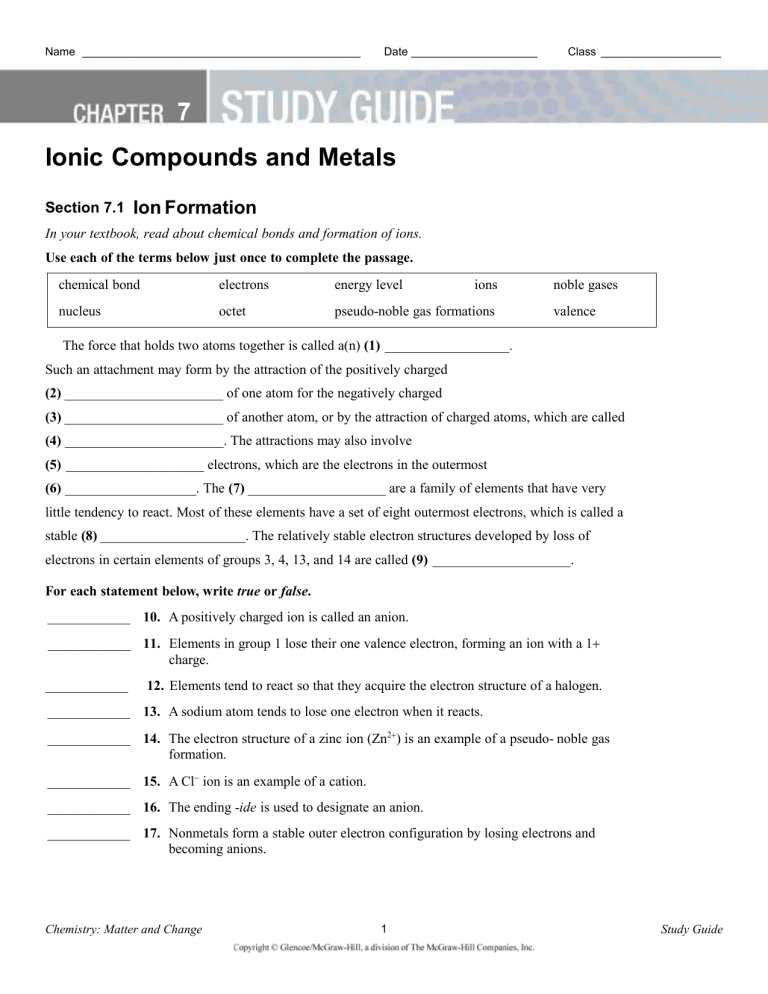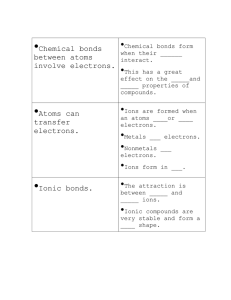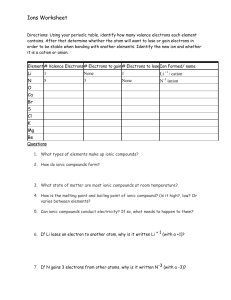
Name ____________________________________________ Date ____________________ Class ___________________ 7 Ionic Compounds and Metals Section 7.1 Ion Formation In your textbook, read about chemical bonds and formation of ions. Use each of the terms below just once to complete the passage. chemical bond electrons energy level ions nucleus octet pseudo-noble gas formations noble gases valence The force that holds two atoms together is called a(n) (1) __________________. Such an attachment may form by the attraction of the positively charged (2) _______________________ of one atom for the negatively charged (3) _______________________ of another atom, or by the attraction of charged atoms, which are called (4) _______________________. The attractions may also involve (5) ____________________ electrons, which are the electrons in the outermost (6) ___________________. The (7) ____________________ are a family of elements that have very little tendency to react. Most of these elements have a set of eight outermost electrons, which is called a stable (8) _____________________. The relatively stable electron structures developed by loss of electrons in certain elements of groups 3, 4, 13, and 14 are called (9) ____________________. For each statement below, write true or false. ____________ 10. A positively charged ion is called an anion. ____________ 11. Elements in group 1 lose their one valence electron, forming an ion with a 1 charge. ____________ 12. Elements tend to react so that they acquire the electron structure of a halogen. ____________ 13. A sodium atom tends to lose one electron when it reacts. ____________ 14. The electron structure of a zinc ion (Zn2) is an example of a pseudo- noble gas formation. ____________ 15. A Clion is an example of a cation. ____________ 16. The ending -ide is used to designate an anion. ____________ 17. Nonmetals form a stable outer electron configuration by losing electrons and becoming anions. Chemistry: Matter and Change 1 Study Guide Name ____________________________________________ Date _________________ Class _________________________ 137 Section 7.2 Ionic Bonds and Ionic Compounds In your textbook, read about forming ionic bonds and the characteristics of ionic compounds. Circle the letter of the choice that best completes the statement or answers the question. 1. An ionic bond is a. attraction of an atom for its electrons. b. attraction of atoms for electrons they share. c. a force that holds together atoms that are oppositely charged. d. the movement of electrons from one atom to another. 2. The formula unit of an ionic compound shows the a. total number of each kind of ion in a sample. b. simplest ratio of the ions. c. numbers of atoms within each molecule. d. number of nearest neighboring ions surrounding each kind of ion. 3. The overall charge of a formula unit for an ionic compound a. is always zero. c. is always positive. b. is always negative. d. may have any value. 4. How many chloride (Cl) ions are present in a formula unit of magnesium chloride, given that the charge on a Mg ion is 2? a. one-half b. one c. two d. four 5. Ionic bonds generally occur between a. metals. b. nonmetals. c. a metal and a nonmetal. d. noble gases. 6. Salts are examples of a. nonionic compounds. b. metals. c. nonmetals. d. ionic compounds. 7. A three-dimensional arrangement of particles in an ionic solid is called a(n) a. crystal lattice. c. formula unit. b. sea of electrons. d. electrolyte. 8. In a crystal lattice of an ionic compound, a. ions of a given charge are clustered together, far from ions of the opposite charge. b. ions are surrounded by ions of the opposite charge. c. a sea of electrons surrounds the ions. d. neutral molecules are present. Chemistry: Matter and Change 2 Study Guide Name ____________________________________________ Date _________________ Class _________________________ 137 Section 7.2 continued 9. What is the relationship between lattice energy and the strength of the attractive force holding ions in place? a. The more positive the lattice energy is, the greater the force. b. The more negative the lattice energy is, the greater the force. c. The closer the lattice energy is to zero, the greater the force. d. There is no relationship between the two quantities. 10. The formation of a stable ionic compound from ions a. is always exothermic. c. is always endothermic. b. may be either exothermic or endothermic. d. neither absorbs nor releases energy. 11. In electron transfer involving a metallic atom and a nonmetallic atom during ion formation, which of the following is correct? a. The metallic atom gains electrons from the nonmetallic atom. b. The nonmetallic atom gains electrons from the metallic atom. c. Both atoms gain electrons. d. Neither atom gains electrons. Underline the word that correctly describes each property in ionic compounds. 12. Melting point Low High 13. Boiling point Low High 14. Hardness Hard Soft 15. Brittleness Flexible Brittle 16. Electrical conductivity in the solid state Good Poor 17. Electrical conductivity in the liquid state Good Poor 18. Electrical conductivity when dissolved in water Good Poor For each statement below, write true or false. ____________ 19. The crystal lattice of ionic compounds affects their melting and boiling points. ____________ 20. The lattice energy is the energy required to separate the ions of an ionic compound. ____________ 21. The energy of an ionic compound is higher than that of the separate elements that formed it. ____________ 22. Large ions tend to produce a more negative value for lattice energy than smaller ions do. ____________ 23. Ions that have larger charges tend to produce a more negative lattice energy than ions with smaller charges do. Chemistry: Matter and Change 3 Study Guide Name ____________________________________________ Date _________________ Class _________________________ 137 Section 7.3 Names and Formulas for Ionic Compounds In your textbook, read about communicating what is in a compound and naming ions and ionic compounds. Use each of the terms below just once to complete the passage. anion -ate cation electrons zero lower right monatomic one oxidation number -ite oxyanion polyatomic subscript A one-atom ion is called a(n) (1) ___________________ ion. The charge of such an ion is equal to the atom’s (2) _________________, which is the number of (3) ________________ transferred to or from the atom to form the ion. In ionic compounds, the sum of the charges of all the ions equals (4) ________________. Ions made up of more than one atom are called (5) ___________________ ions. If such an ion is negatively charged and includes one or more oxygen atoms, it is called a(n) (6) _____________________. If two such ions can be formed that contain different numbers of oxygen atoms, the name for the ion with more oxygen atoms ends with the suffix (7) __________________. The name for the ion with fewer oxygen atoms ends with (8) ____________________. In the chemical formula for any ionic compound, the chemical symbol for the (9) _________________________ is written first, followed by the chemical symbol for the (10) ____________________. A(n) (11) ______________________ is a small number used to represent the number of ions of a given element in a chemical formula. Such numbers are written to the (12) ________________________ of the symbol for the element. If no number appears, the assumption is that the number equals (13) _______________________. For each formula in Column A, write the letter of the matching name in Column B. Column A Column B _________ 14. ClO2 a. chlorate _________ 15. ClO4 b. hypochlorite _________ 16. ClO c. chloride _________ 17. Cl d. perchlorate _________ 18. ClO3 e. chlorite Chemistry: Matter and Change 4 Study Guide Name ____________________________________________ Date _________________ Class _________________________ 137 Section 7.3 continued For each of the following chemical formulas, write the correct name of the ionic compound represented. You may refer to the periodic table on pages 178–179 for help. 19. NaI ___________________________________________________________________________________________ 20. CaCl2 _________________________________________________________________________________________ 21. K2S __________________________________________________________________________________________ 22. MgO _________________________________________________________________________________________ 23. LiHSO4 _______________________________________________________________________________________ 24. NH4Br ________________________________________________________________________________________ 25. Ca3N2 ________________________________________________________________________________________ 26. Cs3P _________________________________________________________________________________________ 27. KBrO ________________________________________________________________________________________ 28. Mg(ClO)2 _____________________________________________________________________________________ 29. Li2O2 _________________________________________________________________________________________ 30. Be3(PO4)2 _____________________________________________________________________________________ 31. (NH4)2CO3 ____________________________________________________________________________________ 32. NaBrO3 _______________________________________________________________________________________ 33. Fe2O3 _________________________________________________________________________________________ 34. Fe(IO3)2 _______________________________________________________________________________________ For each of the following ionic compounds, write the correct formula for the compound. You may refer to the periodic table on pages 178–179 for help. 35. beryllium nitride _______________________________________________________________________________ 36. nickel(II) chloride ______________________________________________________________________________ 37. potassium chlorite ______________________________________________________________________________ 38. copper(I) oxide ________________________________________________________________________________ 39. magnesium sulfite ______________________________________________________________________________ 40. ammonium sulfide ______________________________________________________________________________ 41. calcium iodate _________________________________________________________________________________ 42. iron(III) perchlorate _____________________________________________________________________________ 43. sodium nitride _________________________________________________________________________________ Chemistry: Matter and Change 5 Study Guide Name ____________________________________________ Date _________________ Class _________________________ 137 Section 7.4 Metallic Bonds and the Properties of Metals In your textbook, read about metallic bonds. Use the diagram of metallic bonding to answer the following questions. 1. What is the name of the model of metallic bonding that is illustrated? _________________________________________________________ 2. Why are the electrons in a metallic solid described as delocalized? _________________________________________________________ 3. Which electrons from the metal make up the delocalized electrons? _________________________________________________________ 4. Are the metal atoms that are shown cations or anions? How can you tell? ______________________________________________________________________________________ 5. How do the metallic ions differ from the ions that exist in ionic solids? ______________________________________________________________________________________ ______________________________________________________________________________________________ 6. Explain what holds the metal atoms together in the solid. ______________________________________________________________________________________________ In your textbook, read about the properties of metals. For each property, write yes if the property is characteristic of most metals, or no if it is not. If the property is a characteristic of metals, explain how metallic bonding accounts for the property. 7. Malleable _____________________________________________________________________________________ ______________________________________________________________________________________________ 8. Brittle ________________________________________________________________________________________ 9. Lustrous ______________________________________________________________________________________ 10. High melting point ______________________________________________________________________________ 11. Low boiling point _______________________________________________________________________________ 12. Ductile _______________________________________________________________________________________ ______________________________________________________________________________________________ 13. Poor conduction of heat __________________________________________________________________________ 14. Good conduction of electricity ____________________________________________________________________ Chemistry: Matter and Change 6 Study Guide TEACHER GUIDE AND ANSWERS Study Guide - Chapter 7 – Ionic Compounds and Metals 20. true 21. false 22. false Section 7.1 Ion Formation 23. true 1. chemical bond Section 7.3 Names and Formulas for Ionic Compounds 2. nucleus 3. electrons 4. ions 1. monatomic 5. valence 2. oxidation number 6. energy level 3. electrons 7. noble gases 4. zero 8. octet 5. polyatomic 9. pseudo-noble gas formations 6. oxyanion 10. false 7. –ate 11. true 8. –ite 12. false 9. cation 13. true 10. anion 14. true 11. subscript 15. false 12. lower right 16. true 13. one 17. false 14. e 15. d Section 7.2 Ionic Bonds and Ionic Compounds 16. b 1. c 17. c 2. b 18. a 3. a 19. sodium iodide 4. c 20. calcium chloride 5. c 21. potassium sulfide 6. d 22. magnesium oxide 7. a 23. lithium hydrogen sulfate 8. b 24. ammonium bromide 9. b 25. calcium nitride 10. b 26. cesium phosphide 11. b 27. potassium bromate 12. high 28. magnesium hypochlorite 13. high 29. lithium peroxide 14. hard 30. beryllium phosphate 15. brittle 31. ammonium carbonate 16. poor 32. sodium bromate 17. good 33. iron(III) oxide 18. good 34. iron(II) iodate 19. true 35. Be3N2 Chemistry: Matter and Change 7 Teacher Guide and Answers TEACHER GUIDE AND ANSWERS 36. NiCl2 37. KClO2 38. Cu2O 39. MgSO3 40. (NH4)2S 41. Ca(IO3)2 42. Fe(ClO4)3 43. Na3N Section 7.4 Metallic Bonds and the Properties of Metals 1. electron sea model 2. They are free to move from one atom to another. 3. the valence electrons 4. Cations; they are positively charged. 5. The electrons are not completely lost by the metal 6. 7. 8. 9. 10. 11. 12. 13. atoms, as they are in an ionic solid. They are bonded by the oppositely charged electron sea that surrounds them. Yes; when the metal is hammered, the delocalized electrons move, keeping the metallic bonds intact. no Yes; the delocalized electrons move, absorb and release protons. Yes; the metallic bonds are strong. no Yes; when the metal is pulled, the delocalized electrons move, keeping the metallic bonds intact. no 14. Yes; the delocalized electrons are mobile. Chemistry: Matter and Change 8 Teacher Guide and Answers



